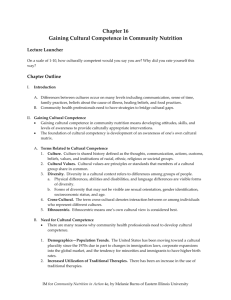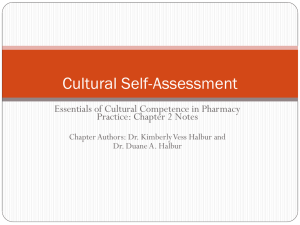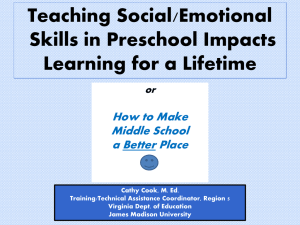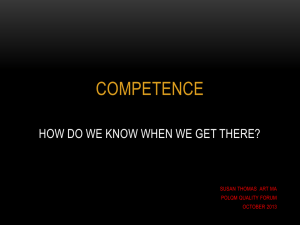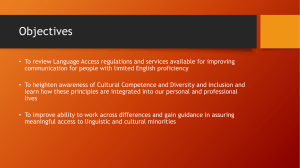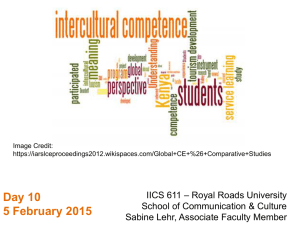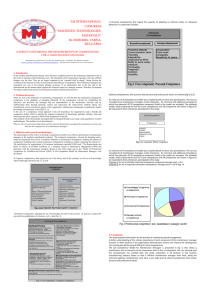Presentation--Disparities and Cultural Competence in STD Programs
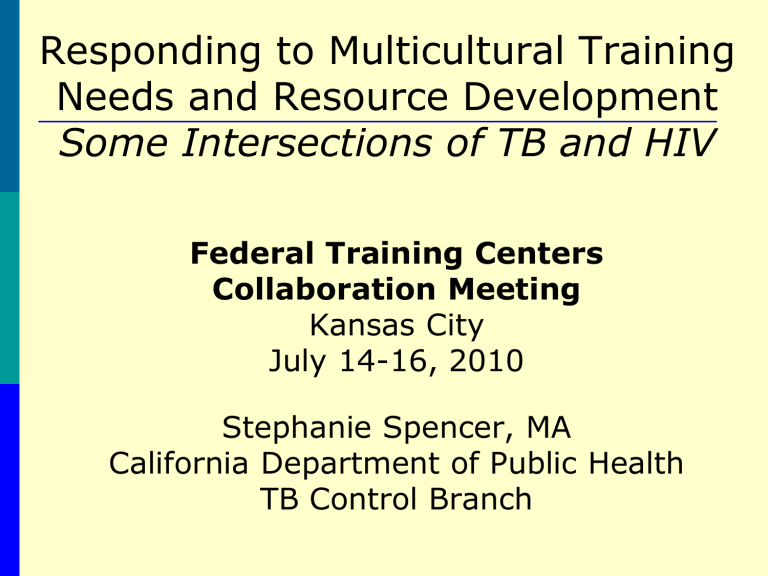
Responding to Multicultural Training
Needs and Resource Development
Some Intersections of TB and HIV
Federal Training Centers
Collaboration Meeting
Kansas City
July 14-16, 2010
Stephanie Spencer, MA
California Department of Public Health
TB Control Branch
How does culture shape TB & HIV and identify cross-cultural training needs?
System factors: Culture shapes U.S. economic and political systems; Culture shapes the healthcare system Disparities exist in access to health care
Provider factors: Culture shapes attitudes and beliefs about cultural groups; culture influences clinician / staff attitudes/ beliefs about groups and about health care
Patient factors: Culture shapes patients’ health beliefs and practices, patients’ experiences of health care system, patients’ abilities to deal with health concerns
2
Specific Cultural Aspects of HIV/AIDS & TB
(sexual activity; expression, regulation of desire) death and dying cleanliness and contamination guilt or innocence; reward and punishment tradition and culture change gender roles & relationships social class relationships economic and power structures meaning/symbolism of body fluids ideas about personal and social responsibility prevention and treatment/latent vs. active disease personal and affinity-group identity substance use
3
Epidemiology Helps Identify Cultural Groups and Cross-cultural Factors
Epidemiologic information on HIV/AIDS and TB…
When are people being diagnosed?
Is incidence changing over time?
Who is affected?
Where are affected people…
…living when they are diagnosed?
…being diagnosed?
How are people becoming infected?
…points to the groups of people that programs need to target for prevention and treatment
But, epi data doesn’t give enough information about these groups to design specific, effective interventions or disease investigations
4
HIV Disparities: Interaction of Environment,
Culture, and Sexual Networks
Environment
Culture
Sexuality-related beliefs, attitudes, values, norms, behaviors, gender roles; internalized
Racism; language; immigration
Experience; etc.
External Racism
Discrimination
Crime/Incarceration
Homicide
Gender Imbalance Ratio
Education/Drop-Outs
Health Care Access
Sexual Networks
Structure
Segregation
Concurrency
Dissortative Mixing
Duration of Infection
STD Prevalence
TB Infection
5
TB Risk Factors in U.S. Present
Cross-cultural Training Needs
Birth in a high TB incidence country
Drug/Alcohol abuse
Incarcerated
Homeless
U.S.-born racial/ethnic minority, especially if at least one parent is foreign-born
6
TB Risk Factors in California
75% are born in TB high incidence countries
Top five countries of origin of TB cases:
China
India
Mexico
Philippines
Vietnam
10% have these risk factors
Drug/Alcohol abuse
Incarcerated
Homeless
U.S.-born racial/ethnic minority, especially if at least one parent is foreign-born
7
All factors present cross-cultural training needs
Beliefs are not mutually exclusive
A Paul Farmer example...
Source: Tracy Kidder. Mountains Beyond Mountains: The Quest of Dr. Paul Farmer,
a Man Who Would Cure the World. Random House, 2003, pp. 33-35.
8
Continuum of Cultural Competence
Lacks cultural awareness and thinks there is only one way of doing things
Culturally
Incompetent
Views themselves as culturally superior to other cultures
Recognizes different cultures and seeks to learn about them
Sees all the same people, and thinks everyone should be treated the same
Actively seeks knowledge about other cultures; educates others about cultural differences
Culturally
Competent
Accepts, appreciates and accommodates cultural differences.
Understands the effect his/her own culture has in relating to others
9
Developing Cross-Cultural Competence
Understanding the background, cultural values, and beliefs of patients, and applying that understanding in a health context.
Cultural competency is the genuine sensitivity and respect given to people regardless of their ethnicity, race, language, culture or national origin.
Ability to anticipate and recognize misunderstandings that arise from the differing cultural assumptions and expectations of providers and patients and to respond to such issues appropriately.
http://www.cahealthadvocates.org/_docs/cmc/2008/Importance-Language-
Services-2008.ppt#385,8,Cultural Competence
10
Developing Cultural Competence:
Fundamental Attitudes
Non-judgmental approach to another’s culture
Cultural humility about one’s own beliefs
Awareness of one’s own biases and assumptions
Willing and able to explain and describe one’s perspectives to others
Desire to understand others’ perspectives
Flexibility to negotiate toward desired outcomes
11
Skills for Cultural Competence (1) —
Document for performance reviews
Questioning skills to learn about a patient’s or partner’s culture—including how a systematic set of cultural health beliefs and health practices makes sense
Observational skills to learn about a patient’s and group’s access to health care and other social needs
Communication skills to effectively negotiate with people of different cultural backgrounds about their health beliefs, behaviors, and access needs
12
Skills For Cultural Competence (2) —
Document for performance reviews
Awareness of communication styles
types and degrees of politeness
varying amounts of directness in questions and answers
story telling as answers to questions
focus on the task or focus on the person
importance of eye contact or body language
Provide explanations to clients about why certain questions are asked or why you are doing certain things
13
Complementary Strategies to build and document cultural competence
Individual staff strategies
Understand and explain own culture
Actively acquire cultural knowledge and skills, including subcultures
Cross-cultural communication, negotiation skills
Programmatic strategies
Bridging structural factors of health disparities
Language access & support for cultural practices
Organizational partnerships / integration
14
Cultural Competence Training Process
Educate staff about culture
basic concepts and definitions, self-awareness
specific knowledge about cultural groups
Continuity and self-peer review
cultural competence self-assessments
case conferences focusing on cultural issues
critical incident discussions
Include patient/community member
in cultural competence assessment, case conference for mutual learning
planning interventions & services
15
Developing Programmatic Cultural
Competence
Start by providing staff a shared framework for talking about culture (definition)
Identify primary cultural groups with highest incidence of STDs and for each group list age, risk behavior, ethnicity/language, etc.
Plan specific times for learning about these cultures
Identify resources to teach—staff, community members, trainers
Structure specific activities—workshops, speakers, staff discussions, community events, critical incident debriefing
Build in evaluation processes—staff goals, increase in partner notification,
16
Programmatic Strategies to Build
Cultural Competence (1)
Language Access
Find out which are most common languages in your jurisdiction
Identify interpretation resources and funding before you need them, including bilingual staff
Train staff to identify and accommodate client interpretation needs
Develop effective ways of letting patients know that interpretation is available at no cost to them
Implement interpreter training standards for language skills and STD-specific training
17
Programmatic Strategies to Build
Cultural Competence (2)
Support for Cultural Practices
Acknowledge and respect ethnomedical explanations and treatments while negotiating biomedical treatment
Support family decision making while ensuring legalities of patient consent
Are there cultural healers you can involve?
Are there effective outreach or treatment practices in clients’ communities or from home countries that you can adapt?
18
Programmatic strategies to build cultural competence (3)
Resources for Cultural Knowledge
Non-medical specialists
social scientists
members of cultural heritage or identity groups
“traditional” or “alternative” healers
patients themselves
patients’ families
community members
19
Programmatic strategies to build cultural competence (4)
Community Partnerships
Which local ethnic, cultural or advocacy groups have community organizations?
Can you partner with them for outreach or to help plan accessible services?
Do any of these organizations have opinion leaders, cultural brokers, trained interpreters?
Do these organizations know anything about
STDs, HIV/AIDS?
Do these organizations have formal or informal support services for patients, partners, families?
20
Reaching the goal: culturally appropriate and effective services
Culturally competent staff and programs can develop individual patient-centered care that includes clients’ cultures and biomedical best practices:
Culture Care Preservation
Culture Care Accommodation
Culture Care Repatterning
21

